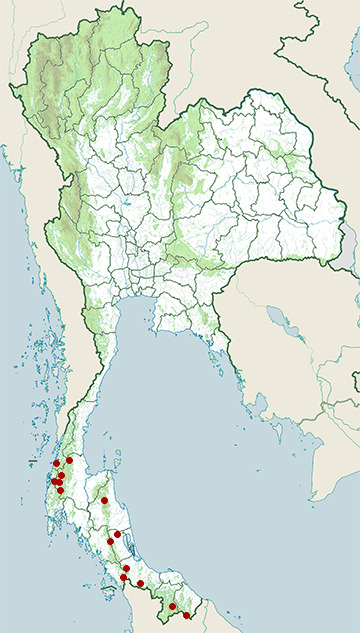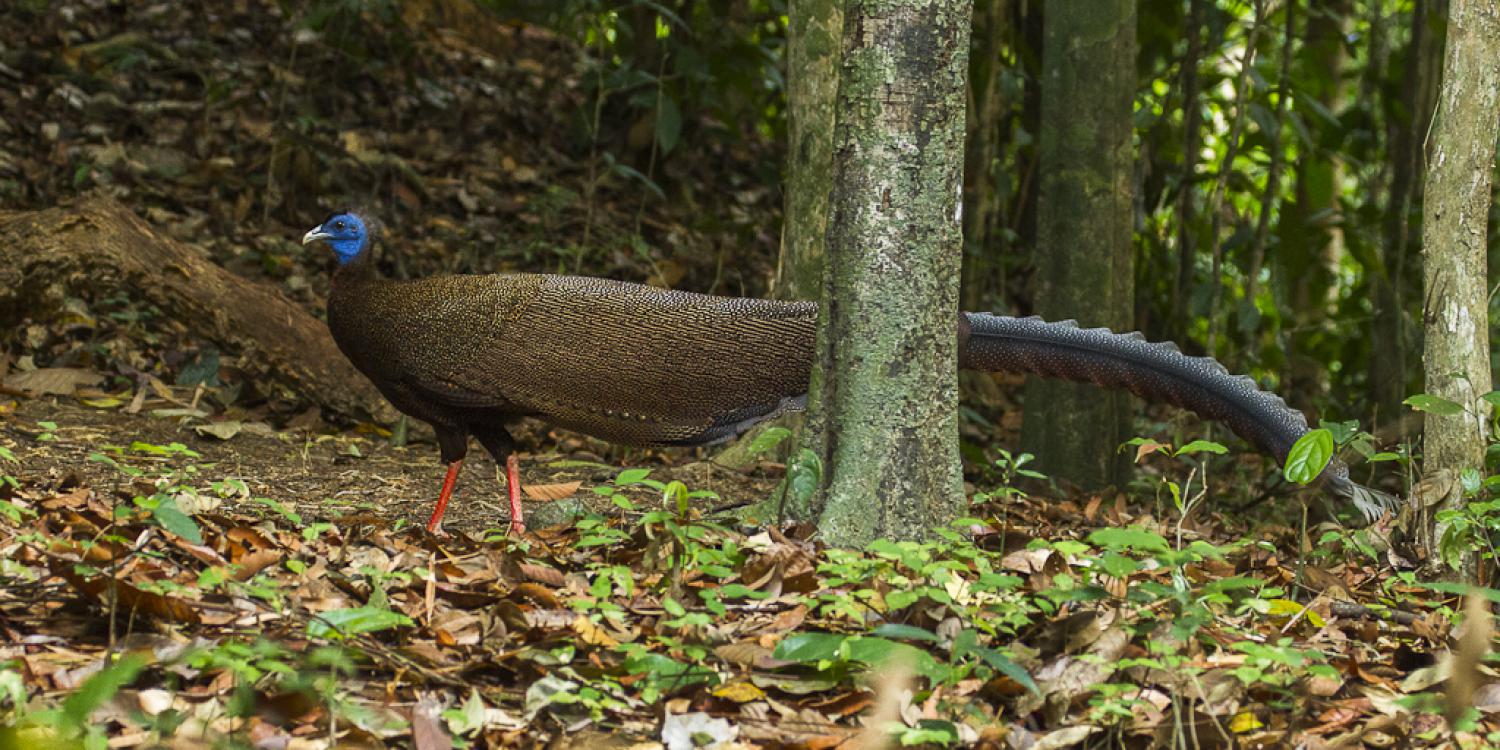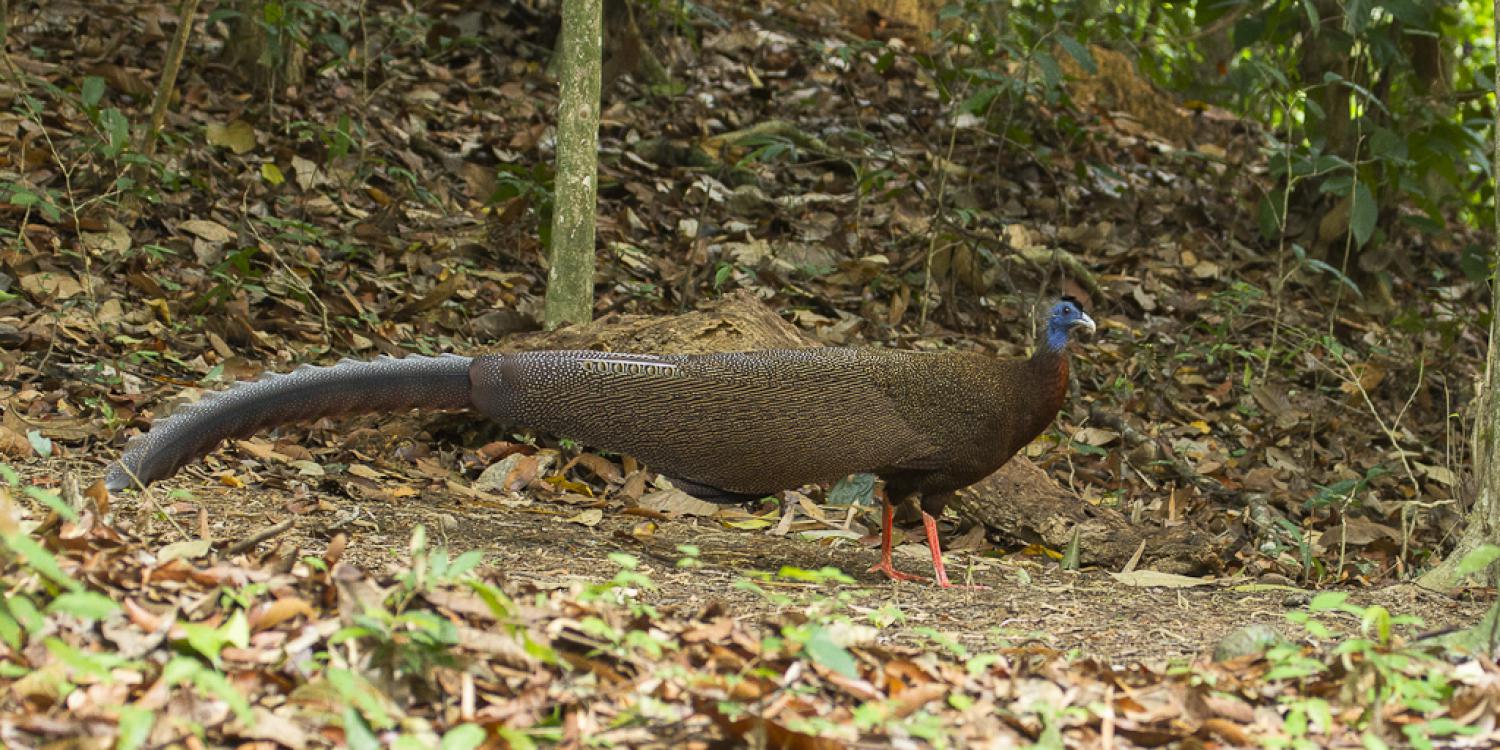Species of Thailand
Great argus
Argusianus argus
Carolus Linnaeus, 1766
In Thai: นกหว้า
The great argus (Argusianus argus) is a species of pheasant from Southeast Asia.
Taxonomy
Carl Linnaeus gave the great argus its specific name (from which its common name and genus name are derived) because of the intricate eye-like patterns on its wings, in reference to Argus, a hundred-eyed giant in Greek mythology. There are two subspecies recognized: Nominate argus of the Malay peninsula and Sumatra, and A. a. grayi of Borneo. William Beebe considered the two races to be distinct species, but they have since been lumped.
Double-banded argus
The double-banded argus (Argusianus bipunctatus), known only from a portion of a single primary flight feather, was long considered a potential second species. It was described in 1871 from this feather piece, found in a millinery shipment imported to London. Its origin was hypothesized to be from Java, Indonesia or Tioman Island of Malaysia, because of the great argus's absence from these locations. Parkes (1992) rejected the double-banded argus's validity and argued that it almost certainly represents a mutant form of the great argus. The IUCN, following the precautionary principle, listed this taxon as extinct until 2012. It was removed from the IUCN Red list because the IOC had removed this species from its list of valid bird taxa in 2011. While the feather is indeed quite distinct, it represents a fairly simple divergence: The entirely asymmetrically-patterned vanes are instead near-symmetrical, and both bear the darker brown shaftward area with dense whitish speckles. The shaft is thinner than usual and the feather would probably not have been useful for flight.
Nothing similar has come to notice ever since, and as the feather piece is not a composite of two feather halves glued together but an apparently natural specimen, a hoax or fake can be ruled out. Despite all conjecture that has been built around the feather piece, all that can be said is that at some time around 1870, an argus pheasant which bore at least one such feather was shot in an unknown location. Even if this individual was one of the last remnants of a now-extinct population, it is unlikely that only a single feather would have been taken from an unusual specimen of a well-known, often-hunted, and conspicuous bird, and that this single feather would have then been bundled into a shipment of normal great argus feathers. The feather is now housed in the Natural History Museum in London.
Description
The great argus is a brown-plumaged pheasant with a blue head and neck, rufous red upper breast, black hair-like feathers on the crown and nape, and red legs. The male is one of the largest of all pheasants, measuring 160 - 200 cm in total length, including a tail of 105 - 143 cm, and weighing 2.04 - 2.72 kg. Males have very long tail feathers and huge, broad and greatly elongated secondary wing feathers decorated with large eyespots. Young males develop their adult plumage in their third year. Females are smaller and duller than males, with shorter tails and fewer eyespots. They measure 72 - 76 cm in total length, including a tail of 30 - 36 cm, and weighs 1.59 - 1.7 kg.
Behaviour
Though the great argus is not as colorful as other pheasants, its display surely ranks among the most remarkable. The male clears an open spot in the forest and prepares a dancing ground. He announces himself with loud calls to attract females, then he dances before her with his wings spread into two enormous fans, revealing hundreds of "eyes" while his real eyes are hidden behind it, staring at her.
Despite displays similar to polygamous birds and though the great argus was thought to be polygamous in the wild, it has been discovered that it is actually monogamous.
It feeds on the forest floor in early morning and evening. Unusual among Galliformes, the great argus has no uropygial gland and the hen lays only two eggs.
Distribution and habitat
The great argus is native to the jungles of Borneo, Sumatra and the Malay Peninsula in southeast Asia.
Conservation
Due to ongoing habitat loss and to being hunted in some areas, the great argus is evaluated as Near Threatened on the IUCN Red List. It is listed on Appendix II of CITES.
This article uses material from Wikipedia released under the Creative Commons Attribution-Share-Alike Licence 3.0. Eventual photos shown in this page may or may not be from Wikipedia, please see the license details for photos in photo by-lines.
Category / Seasonal Status
BCST Category: Recorded in an apparently wild state within the last 50 years
BCST Seasonal status: Resident or presumed resident
Scientific classification
- Kingdom
- Animalia
- Phylum
- Chordata
- Class
- Aves
- Order
- Galliformes
- Family
- Phasianidae
- Genus
- Argusianus
- Species
- Argusianus argus
Common names
- English: Great argus
- Spanish: Argos real
- Thai: นกหว้า
Synonyms
- Argus bipunctatus, Perry L. Wood Jr (1871)
- Phasianus argus, Carolus Linnaeus (1766)
- Argusianus bipunctatus
Conservation status

Near Threatened (IUCN3.1)

Near Threatened (BirdLife)

Vulnerable (ONEP)

Vulnerable (BCST)
Photos
Please help us review the bird photos if wrong ones are used. We can be reached via our contact us page.
Range Map

- Bang Lang National Park
- Hala-Bala Wildlife Sanctuary
- Kaeng Krung National Park
- Khao Banthat Wildlife Sanctuary
- Khao Luang National Park
- Khao Nam Khang National Park
- Khao Sok National Park
- Khlong Nakha Wildlife Sanctuary
- Khlong Phanom National Park
- Khlong Saeng Wildlife Sanctuary
- Khuan Khanun District, Phatthalung
- Sri Phang Nga National Park
- Thale Ban National Park
- Ton Nga-Chang Wildlife Sanctuary

